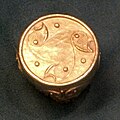British Iron Age
This article needs additional citations for verification. (March 2011) |
| Geographical range | British Isles |
|---|---|
| Period | Iron Age, Hallstatt culture, La Tène culture |
| Dates | c. 800 BC—43 AD |
| Preceded by | Bronze Age Britain, Atlantic Bronze Age, Urnfield culture |
| Followed by | Roman Empire, Roman Britain |

The British Iron Age is a conventional name used in the
The Iron Age is not anThe British Iron Age followed the British Bronze Age and lasted in theory from the first significant use of iron for tools and weapons in Britain to the Romanisation of the southern half of the island. The Romanised culture is termed Roman Britain and is considered to supplant the British Iron Age.
The tribes living in Britain during this time are often popularly considered to be part of a broadly-
Periodisation
At present over 100 large-scale excavations of Iron Age sites have taken place,[4] dating from the 8th century BC to the 1st century AD and overlapping into the Bronze Age in the 8th century BC.[5] Hundreds of radiocarbon dates have been acquired and have been calibrated on four different curves, the most precise being based on tree ring sequences.
The following scheme summarises a comparative chart presented in a 2005 book by
| Period | Dates | Continental parallels |
|---|---|---|
| Earliest Iron Age | 800–600 BC | Hallstatt C |
| Early Iron Age | 600–400 BC | Hallstatt D and half of La Tène I |
| Middle Iron Age | 400–100 BC | The rest of La Tène I, all of II and half of III |
| Late Iron Age | 100–50 BC | The rest of La Tène III |
| Latest Iron Age | 50 BC – AD 100 | –
|
The Iron Age has been further subdivided with the "Late Iron Age" in Britain showing developments of new types of pottery, possibly influenced by Roman or Gaulish cultures. The clearing of forests for cultivation of agricultural crops intensified and areas with heavier and damper soil were settled. Spelt (Triticum spelta) was planted in these areas like the Tees Lowlands and some parts of Northern England.[7]
The end of the Iron Age extends into the very early
Archaeological evidence
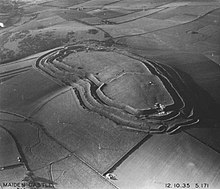
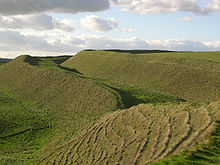
Attempts to understand the human behaviour of the period have traditionally focused on the geographic position of the islands and their landscape, along with the channels of influence coming from Continental Europe.
During the later
By the 8th century BC, there is increasing evidence of Great Britain becoming closely tied to Continental Europe, especially in Southern and Eastern Britain. New weapon types appeared with clear parallels to those on the Continent, such as the
Defensive structures dating from this time are often impressive such as the
The development of hill forts may have occurred from greater tensions that arose between the better-structured and more populous social groups. Alternatively, there are suggestions that in the latter phases of the Iron Age, the structures simply indicate a greater accumulation of wealth and a higher standard of living although any such shift is invisible in the archaeological record for the Middle Iron Age, when hill forts come into their own.
People of Iron Age Britain
Britain, we are told, is inhabited by tribes which are autochthonous and preserve in their ways of living the ancient manner of life. They use chariots, for instance, in their wars, even as tradition tells us the old Greek heroes did in the Trojan War.
Celtic movement from Continent

The Roman historian
From the early 20th century, the "invasionist" scenario was juxtaposed to a
There was certainly a large migration of people from Central Europe westwards during the early Iron Age. The question whether these movements should be described as "invasions", as "migrations" or as mostly "diffusion" is largely a semantic one.
Examples of events that could be labelled "invasions" include the arrival in Southern Britain of the
Demography

The population of Britain increased significantly during the Iron Age probably to more than one million, partly due to improved barley and wheat and increased use of peas, beans and flax.Richards, Julian. "Overview: Iron Age, 800 BC - AD 43". BBC. Retrieved March 31, 2024. Most were concentrated densely in the agricultural lands of the South. Settlement density and a land shortage may have contributed to rising tensions during the period. The average life expectancy at birth would have been around 25, but at the age of five, it would have been around 30.[citation needed] Those figures would be slightly lower for women, and slightly higher for men throughout the Middle Iron Age in most areas, on account of the high mortality rate of young women during childbirth; however, the average age for the two sexes would be roughly equal for the Late Iron Age.[citation needed] That interpretation depends on the view that warfare and social strife increased in the Late Iron Age, which seems to be fairly well attested in the archaeological record for Southern Britain at least.
Early in the Iron Age, the widespread Wessex pottery of Southern Britain, such as the type style from All Cannings Cross, may suggest a consolidated socio-economic group in the region. However, by 600 BC, that appears to have broken down into differing sub-groups with their own pottery styles.[18] Between c. 400 and 100 BC, there is evidence of emerging regional identities and a significant population increase.[19]
Ptolemy's Albion
-
Roundhouse reconstruction, Wales
-
Tre'r Ceiri hillfort, Wales
-
'Earth house' reconstruction, interior, England.[21]
-
Crannog reconstruction, Scotland
-
Remains of fortifications at the Stanwick hillfort, England
-
Silchester Iron Age town, England
-
Broch of Dun Troddan, Scotland, internal stairs
-
Old Oswestry hillfort remains, England
Iron Age beliefs in Britain

The Romans described a variety of deities worshipped by the people of Northwestern Europe. Barry Cunliffe perceives a division between one group of gods relating to masculinity, the sky and individual tribes and a second group of goddesses relating to associations with fertility, the earth and a universality that transcended tribal differences. Wells and springs had female, divine links exemplified by the goddess Sulis worshipped at Bath. In Tacitus's Agricola (2.21), he notes the similarity between both religious and ritual practices of the pre-Roman British and the Gauls.[22]
Religious practices often involved the ritual slaughter of animals or the deposition of metalwork, especially war booty. Weapons and horse trappings have been found in the bog at Llyn Cerrig Bach on Anglesey and are interpreted as votive offerings cast into a lake. Numerous weapons have also been recovered from rivers, especially the Thames but also the Trent and Tyne. Some buried hoards of jewellery are interpreted as gifts to the earth gods.
Disused grain storage pits and the ends of ditches have also produced what appear to be deliberately-placed deposits, including a preference for burials of horses, dogs and ravens. The bodies were often mutilated, and some human finds at the bottom of pits, such as those found at Danebury, may have had a ritual aspect.
Caesar's texts state that the priests of Britain were

Overall, the traditional view is that religion was practiced in natural settings in the open air.
Death in Iron Age Great Britain seems to have produced different behaviours in different regions.
Economy of Iron Age Britain

Trade links developed in the Bronze Age and beforehand provided Great Britain with numerous examples of continental craftsmanship. Swords especially were imported, copied and often improved upon by the natives. Early in the period, Hallstatt slashing swords and daggers were a significant import, but by the mid-6th century[clarify], the volume of goods arriving seems to have declined, possibly from more profitable trade centres appearing in the Mediterranean. La Tène culture items (usually associated with the Celts) appeared in later centuries, and again, they were adopted and adapted with alacrity by the locals.
There also appears to have been a collapse in the bronze trade during the early Iron Age, which can be viewed in three ways:
- Steady transition: the development of iron parallel to a diminishing bronze system.
- Rapid abandonment; iron undermines bronze and takes over its social function.
- Bronze crisis: severe reduction in the supply of bronze allows the iron to replace it.
With regard to animal husbandry, cattle represented a significant investment in pre-Roman Britain, as they could be used as a source of portable wealth and to provide useful domestic by-products such as milk, cheese and leather. In the later Iron Age, an apparent shift is visible, revealing a change in dominance from cattle rearing to that of sheep. Economically, sheep are significantly less labour-intensive, requiring fewer people per animal.
Cattle and sheep dominate the osteo-archaeological record, but evidence for pig, ox, dog and rarely chicken is widely represented. There is generally an absence from environmental remains of hunted game and wild species as well as fresh and sea water species, even in coastal communities.
A key commodity of the Iron Age was salt, used for preservation and the supplementation of diet. Though difficult to find archaeologically, some evidence exists.


Representing an important political and economic medium, the vast number of
The expansion of the economy throughout the period, but especially in the later Iron Age, is in large part a reflection of key changes in the expression of social and economic status.
Trade
Early and Middle Iron Age

The Early Iron Age saw a substantial number of goods belonging to the Hallstatt culture imported from the continent, and they came to have a major effect on Middle Iron Age native art.
Late Iron Age
From the late 2nd century BC onwards, South-Central Britain was indirectly linked into Roman trading networks via Brittany and the Atlantic seaways to south-western Gaul.[29] Hengistbury Head in Dorset was the most important trading site, and large quantities of Italian wine amphorae have been found there.[29] These Atlantic trade networks were heavily disrupted following Julius Caesar's failed conquest of Brittany in the 50s BC.[29] This fact may support a supposition that the Celts of Britain had an economic interest in supporting their Gallic brethren in their resistance to Roman occupation.[citation needed]
In South-eastern Britain, meanwhile, extensive contact with the '
After Caesar's conquest of Gaul, a thriving trade developed between South-Eastern Britain and the near Continent. That is archaeologically evidenced by imports of wine and olive oil amphorae and mass-produced Gallo-Belgic pottery.[32] Strabo, writing in the early 1st century AD, lists ivory chains and necklaces, amber gems, glass vessels and other petty wares as articles imported to Britain, and he recorded the island's exports as grain, cattle, gold, silver, iron, hides, slaves and hunting dogs.[33] That trade probably thrived as a result of political links and client kingship relationships that developed between groups in South-Eastern Britain and the Roman world.[34]
-
Celtic sword and scabbard
-
Druid of Colchester surgical tools
-
Remains of an Iron Age village at Chysauster, Cornwall
-
Bryn Eryr farmstead reconstruction
End of Iron Age in Britain
Historically speaking, the
In areas where Roman rule was not strong or non-existent, Iron Age beliefs and practices remained but not without at least marginal levels of Roman or Romano-British influence. The survival of place names, such as Camulodunum (Colchester), which derive from the native language, is evidence of that.
See also
| Part of a series on the |
| Iron Age |
|---|
| ↑ Bronze Age |
| ↓ Ancient history |
Notes
- ^ Cunliffe (2005), p. 27.
- ISBN 978-0-19-821737-4.
- ^ Fitzpatrick (1996) page 242: "It is clear, then, that there is no intrinsic 'Celtic' European unity and that the idea of 'Celtic' Iron Age Europe has developed in an almost ad hoc fashion. When examined critically the central idea – of being 'Celtic' – may also be seen to be weakly formulated ...."
- ^ Cunliffe (2005), p. 20.
- ^ Cunliffe (2005), p. 32.
- ^ Cunliffe (2005), p. 32. The dates are the mid-points of Cunliffe's transitional lines. His earliest and latest possibilities have been used for the end points. In the text, 750 BC is his summary date for the beginning.
- ^ Albarella, Umberto. The end of the Sheep Age: people and animals in the Late Iron Age. p. 391.
- ^ "Maiden Castle". English Heritage. Retrieved 2009-05-31.
- ^ Historic England. "Maiden Castle (451864)". Research records (formerly PastScape). Retrieved 2009-05-27.
- ^ Scottish Archaeological Research Framework (ScARF), Highland Framework, Iron Age (accessed May 2022).
- ^ Scottish Archaeological Research Framework (ScARF), National Framework, Iron Age (accessed May 2022).
- ^ "Book 5, chapter 24". The Library of History of Diodorus Siculus.
- ^ Tacitus, Agricola 11: "Their physical characteristics are various and this is suggestive... overall, however, it seems reasonable to believe that the Gauls occupied this island lying so near to them." (Habitus corporum varii atque ex eo argumenta. [...] In universum tamen aestimanti Gallos vicinam insulam occupasse credibile est.)
- ^ e.g. Grahame Clarg (1966)
- ^ Cunliffe (2010) page 116.
- ^ Cunliffe (2005): "As usual the ball has been swung too far..."[page needed]
- ^ Caesar, Commentarii de Bello Gallico V.12: "The interior part of Britain is inhabited by those who claim to be indigenous on the strength of an oral tradition." (Britanniae pars interior ab eis incolitur quos natos in insula ipsi memoria proditum dicunt...)
- ^ Cunliffe (2010), page 120
- ^ Cunliffe (2010), page 598: "Growth of population was one of the factors which led to the crystallizing out of well-defined social hierarchies accompanied, especially in the centre south, by a degree of territoriality."
- ^ Geography, Book II, Chapter II, on Albion.
- ^ "The Earthouse". Ancient Technology Centre.
- ^ Tacitus, Agricola, translated by Mattingly, H. (revised edition),1979, Harmondsworth: Penguin Books,
- ISBN 978-0-7524-4715-5.
- ^ Score, Vicki (2006). "Rituals, hoards and helmets: a ceremonial meeting place of the Corieltavi" in Transactions of the Leicestershire Archaeological and Historical Society, Vol 80, pp. 197–207.
- .
- ^ The Oxford Celtic Coin Index Archived 2011-05-16 at the Wayback Machine
- ^ The Oxford Celtic Coin Index Archived 2012-06-29 at the Wayback Machine
- ^ Leins, Ian (2007). "Coins in context and votive deposition in Iron Age Southeast Leicestershire" in The British Numismatic Journal, Vol 77, pp. 22-48.
- ^ a b c Cunliffe 1988; Cunliffe (2005); Cunliffe (2009); Cunliffe & de Jersey (1997).
- ^ Sills, J. 2003. Gaulish and Early British Coinage. London: Spink; Cunliffe (2005); Creighton, J. 2000. Coins and Power in Late Iron Age Britain. Cambridge: Cambridge University Press.
- ^ Sills, J. 2003. Gaulish and Early British Coinage. London: Spink; Cunliffe (2009).
- ^ http://gallobelgic.thehumanjourney.net/; Morris, F. M. 2010. North Sea and Channel Connectivity during the Late Iron Age and Roman Period (175/150 BC – AD 409). Oxford: Archaeopress.
- ^ Strabo. Geography. IV.5.2-3.
- ^ Creighton, J. 2000. Coins and Power in Late Iron Age Britain. Cambridge: Cambridge University Press; Morris, F. M. 2010. North Sea and Channel Connectivity during the Late Iron Age and Roman Period (175/150 BC – AD 409). Oxford: Archaeopress.
- ^ Smith, A., 2001, The Differential Use Of Constructed Sacred Space In Southern Britain, from the Late Iron Age to the 4th Century AD BAR British Series 318, Oxford: Archaeopress
- ^ De la Bedoyere, G., 1991, Buildings of Roman Britain, Tempus: Stroud
Bibliography
- Cunliffe, B. W. (1988). Greeks, Romans and Barbarians. London.
{{cite book}}: CS1 maint: location missing publisher (link) - Cunliffe, B. W.; de Jersey, P. (1997). Armorica and Britain: Cross-Channel Relationships in the Late First Millennium BC. Oxford.
- ISBN 0-415-34779-3.
- Cunliffe, B. W. (2009). Clark, P. (ed.). Looking forward: maritime contacts in the first millennium BC. Oxford: Oxbow.
{{cite book}}:|work=ignored (help) - Fitzpatrick, Andrew P (1996). "'Celtic' Iron Age Europe: the theoretical basis". In Graves-Brown, Paul; Jones, Siân; Gamble, Clive (eds.). Cultural Identity and Archaeology: The Construction of European Communities. Routledge. pp. 238–255. ISBN 978-0-415-10676-4.
- Map of Southern Britain in the Iron Age. Chessington, Surrey, UK: Ordnance Survey. 1962.
- Rhys, J. (1904). Celtic Britain: Third Edition Revised. London: Society for Promoting Christian Knowledge. Downloadable Internet Archive.
Further reading
- Collis, J.R., 2003, The Celts, origins, myths, inventions Stroud: Tempus
- Haselgrove, C., 2001, Iron Age Britain in its European Setting, in Collis, J.R. (ed) Settlement and Society in Iron Age Europe, Sheffield: Sheffield Archaeological Monograph 11, pp37–73
- Haselgrove, C. and Moore, T., 2007, The later Iron Age in Britain and beyond, Oxford: Oxbow
- Pryor, F., 2003, Britain, BC; life in Britain and Ireland before the Romans, London: Harper Collins, chapters 11-12
- Hill, J.D., 1995, Ritual and Rubbish in the Iron Age of Wessex BAR British Series 242
External links
- Lindsay, Euan (2008). "Place names on Ptolemy's Map of Scotland". Roman Britain. Archived from the original on 2008-11-21. Retrieved 2008-11-22.
- Ross, David (1996). "Celtic Britain (The Iron Age) c. 600 BC – 50 AD". Celtic Britain. Retrieved 2007-03-13.





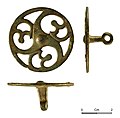

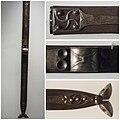










!['Earth house' reconstruction, interior, England.[21]](http://upload.wikimedia.org/wikipedia/commons/thumb/f/f4/Story_telling_at_Ancient_Technology_Centre%2C_Cranborne_-_geograph.org.uk_-_406677.jpg/120px-Story_telling_at_Ancient_Technology_Centre%2C_Cranborne_-_geograph.org.uk_-_406677.jpg)
























